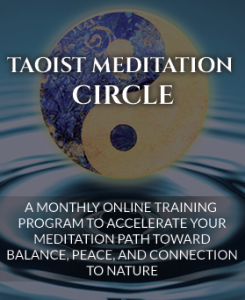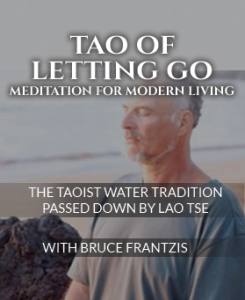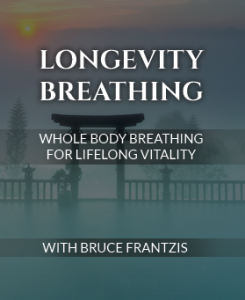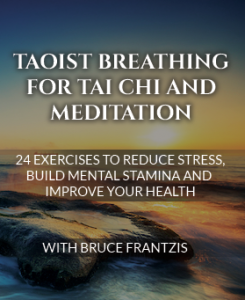Once you’ve breached the barrier between the physical breath and the qi-breath – which is like passing through an invisible membrane into a slightly different reality – you can begin to pull the qi out of the air that you breathe.
Daoist breathing starts with engaging and opening up the physical breath in order to increase the volume of air coming in and out of the lungs. But that is just the beginning.
With this deep, progressive approach to breathing, you can:
- Massage your internal organs.
- Release long-term, bound and accumulated tension from your body.
- Supercharge blood and qi flow.
Breathing for the Body
Progressively implementing Daoist breathing techniques can have a profound effect on your health, as many of you have experienced first-hand. Yet, still benefits remain in the realm of the physical.
By definition qigong is a methodology for cultivating your qi and Daoist breathing is a fundamental aspect of qigong. Initially, in any qigong practice, you start with body mechanics – that is, how your body moves in either a form or, in this case, to activate and engage all of your organs through breathing.
Once you are familiar with the physical elements, the next step is to focus on directly developing your qi.
Breathing to Cultivate Qi
One fundamental principle that students tend to miss is: your qi is naturally flowing already, albeit likely compromised in some way due to whatever stresses, tensions and traumas you are carrying.
Qigong is all about releasing these tensions, so that qi can flow stronger and to all the various areas of the body, both external and internal. Practicing the movements of qigong or the natural Daoist breathing mechanics will open the body, and circulate and develop qi to a certain degree, but shifting into the realm of directly feeling and moving qi will do a whole lot more.
The procedure is a handoff similar to a relay race, where one runner begins the race (body mechanics) and then passes the baton smoothly to the next runner (energy mechanics), who continues the race. However, with Daoist breathing, there is no race, just a personal journey inward to contact your qi and increase your awareness.
From the perspective of Chinese medicine and the neigong system, it is the qi that controls all the body’s functions. In other words, your qi tells your body what to do. If your qi is stagnant, blocked or weak, your body will be sluggish and function poorly. If your qi is free-flowing and strong, you become healthy, vital and alive.
This is the fundamental principle in acupuncture, Dragon and Tiger Medical Qigong and all Daoist practices. This is why it is called qigong or “energy development,” rather than simply the development of the physical structures of the body.
A Doorway to Qi
When it comes to breathing, the breath is a doorway into your qi and possibly the reason why, in the Chinese language, both breath and qi are covered by the same written character. With this in mind, it should start to become very apparent why the proposal of “Breath to Qi” is so important in the development of your qigong practice in general and specifically to your breathing practice.
You want to get to the point where, through your breath, you can recognize, feel, directly experience and manipulate your qi. When you arrive at this point, a whole new world unfolds and you can tune into your qi at any given moment, on any given day or night. You begin to notice when your qi becomes sluggish or weak and then can use your tools to boost your qi when you need to, without having to stop what you are doing to practice a form. You are breathing 24/7, right?!
The sense of the air coming in and out of your lungs falls away into the background and a sense of breathing qi in and out of your body takes over. You literally pull the qi that is all around you, at all times, in through the pores of your skin to increase the quantity of qi circulating throughout your system. This practice wakes up your nerves, increases your awareness, heightens your senses, and dramatically improves health and mental functioning.
Breathing is one of the easiest practices to engage with, gives a high return for your effort, and can be done anywhere or anytime you choose to focus on your breath.
The Process of Breath-to-Qi
If you have been practicing Daoist Breathing for a while and already know the six-part breathing pattern, then you have learned the basic building blocks to be on your way. If not, then spend the time you need to build it up slowly and methodically. Your diligence now will save your future self time. (Daoist breathing instruction and guided practices are offered in every session of Energy Arts Live.)
Once you’ve established the base six-part breathing skill set, then you’ll want to continue through the process again and again. As in all things neigong, it is not what you do, but how well you do it. Running through the six-part breathing process again and again will help you hone and refine your practice, and give you the chance to improve each aspect of your breath. It might be that a small part of your diaphragm releases its bound tension, your lungs open up where before they were stuck, or it could just be that the different parts of the breath gel together better, giving you a smoother overall result.
Whatever the incremental advances are, these improvements will nudge you closer and closer to better breathing, and achieving direct perception of and control over your qi. This process is amplified even more when working through the breathing practices directly with a Daoist Master, as teachings can be accompanied by critical transmissions that can help carry you into the realm of qi. Without this support and guidance, chances of success are significantly more challenging.
The Snowball Effect
This July-August, my teacher Bruce will offer a Breath to Qi Retreat in Colorado, where you will have the rare opportunity to sit with him and be guided through the process by a true Daoist master who may never offer this teaching publicly again.
My experience of the first training in Crete in 2010 was that the teachings and accompanying transmissions we received in the early stages of the Breath to Qi training soaked into me and built up – slowly at first, but a week or so in, they naturally amplified and that continued exponentially with practice. You could think of a ball rolling down a snowy mountain. It picks up in size with each revolution.
Many experienced students reported that they didn’t notice much change to their breathing in the early days, but later, it suddenly crept up on us in a very yin way. And when it did, we broke through that invisible membrane and entered into the realm of qi. From there, it was a new world of questions and discoveries – what could we achieve with our breath and in what ways could our breath affect our qi?
To this day, I am personally grateful to Bruce for the opportunity to train this profound practice and receive these rare transmissions normally reserved for disciples. My breathing transformed during that retreat and will never revert back to simply drawing in air.
Breathing and Meditation
Breathing practice is often quoted as the doorway to meditation, as a highly refined breath settles the mind and allows you to recognize what is happening below the surface. Breaching the barrier into the subtle qi of the body draws you deeper into yourself and gives you access to the subliminal. Breathing is a way in, if you will, to the deeper aspects of yourself, which is an absolute requirement to engage in Daoist or any other genuine meditation method.
Of course it is possible to engage in meditation without having achieved breath to qi, but the point is: qi can serve as a bridge from experiencing yourself as only physical to engaging with the far more subtle aspects of your being. Becoming aware of and directly experiencing your qi can remove one very important obstacle on the road toward unification of body, mind and qi.
Whether you are interested in stress management, building better health, increasing your awareness, recognizing and controlling your qi or sinking into deep meditation practice, the jump from breath to qi is sure to serve you on your path.
Join us on retreat this summer – in person in Longmont, Colorado or online!
One-week retreat with Senior Instructors Bill Ryan, Paul Cavel and Craig Barnes:
→ Foundational Qigong with Six-part Breathing Warm-up
Two- or three-week retreat with Master B.K. Frantzis:
→ Daoist Breathing: Breath to Qi








Very inspiring as always. Thankyou for your clear explanations and insights